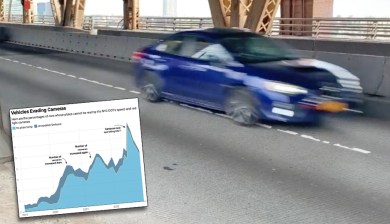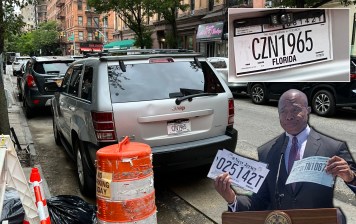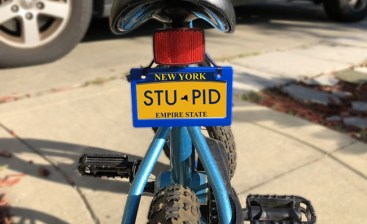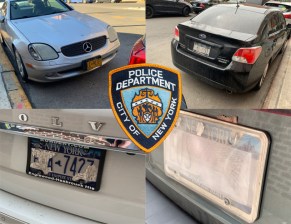Mayor Adams on Fake Plate Crackdown: ‘This Time, It Will Happen Because Eric Adams is Mayor’
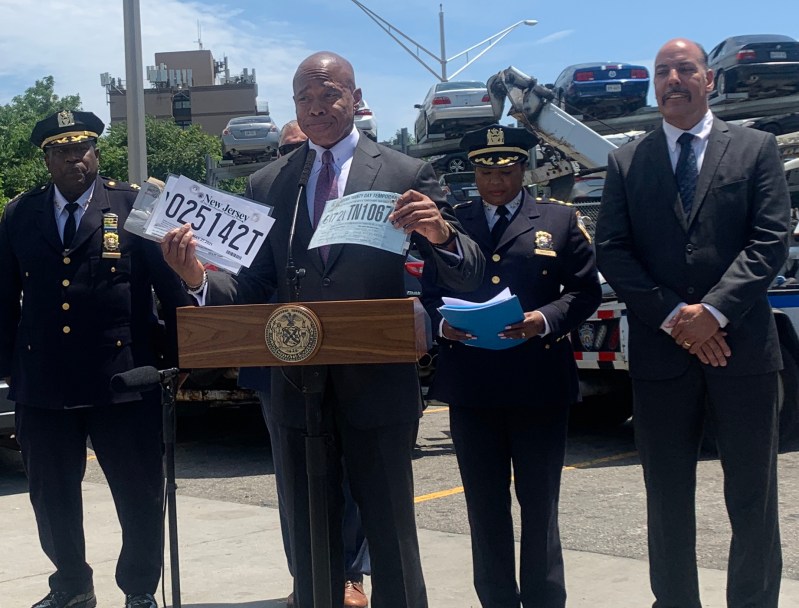
OK, bad guys, now you’re really really on notice.
Mayor Adams and law enforcement officials — sounding very much like many previous officials — said they are really going after cars with fake license plates or fraudulent or expired paper license plates because such cars tend to be disproportionately in criminal behavior. But unlike prior efforts to rein in reckless and unregistered drivers, this one will succeed for one reason, the mayor said.
“The sole thing that’s different from those who talked about it before and those who are talking about it now is Eric Adams — I’m the mayor now,” Hizzoner told reporters at a press event at a Queens tow pound. “You’re going to see us aggressively address this problem.”
The mayor and his team did not announce any new initiative; indeed, the first sentence of the press release from the NYPD certainly didn’t oversell anything: “Mayor Eric Adams, the New York City Sheriff’s Office, and the New York City Police Department today put drivers on notice that the NYPD and Sheriff’s Office will tow — and could potentially auction off — vehicles caught with illegal, fake, paper license plates.” (This was, of course, true before Adams took office.)
Officials pledged that they are serious.
“I want it to be clear: this is not a summer initiative, or a July crackdown. This is an active, ongoing part of the daily and nightly work of every NYPD police officer and investigator,” NYPD Transportation Bureau Chief Kim Royster said. “This is a warning to all, this ends today.”
On the plus side, the NYPD and Sheriff Anthony Miranda did provide some evidence that better enforcement of illegal plates is ongoing. For example:
- Through June of this year, police officers and traffic enforcement agents issued 13,250 summonses to vehicles with covered license plates, which is a 33-percent increase compared to the 9,956 summonses issued in the same period last year, the NYPD said.
- Arrests involving vehicles displaying temporary plates rose to 3,568 in the last year of the de Blasio administration, which is a 300-percent increase compared to 2016, when 893 people were arrested for fake plates.
- Last year, roughly 25 percent of the 5,500 vehicles with paper plates that were towed away were never retrieved by their owners. So far this year, that percentage has risen to 34 percent, a hint at the increasing prevalence of this problem. That said, only 1,646 vehicles have been towed away with paper plates through the first six months of this year, which would represent a 40-percent decrease in towing, if the towing continues at the current rate.
Adams and his team spoke in front of a tableau of criminal car culture. That 2014 Maserati behind him? When it was towed away, cops found a 40-caliber pistol and crack cocaine inside, and arrested the driver with a suspended license, Adams said.

That white Jeep Wrangler? It had been spotted driving in the shoulder, and the driver fled when police followed, then abandoned the car for a foot race that he lost. When he was arrested, Adams said, he was carrying a gun.
That 2007 Dodge Caliber? Cops spotted its driver going in the wrong direction in the Bronx and when they caught up with him, it turns out he was driving while intoxicated, Adams said.
In addition, the stolen Honda that a driver used to kill a grandmother and seriously injure her 8-year-old grandson on June 25 had an expired (and fake) South Carolina license plate.
Of the 272 traffic related deaths in New York last year, 16 involved vehicles with temporary license plates, Adams added. And Royster added that cops have spotted the same fake plates on different vehicles fleeing scenes of separate crimes. Maybe one plate is real, but they can’t all be. Streetsblog has also documented that drivers of cars with out-of-state plates cause a disproportionate amount of mayhem.
“When you see people using these paper plates, many times they are doing something [else] illegal,” he said. “We have not connected to dots, historically, and we believed that these quality-of-life issues had nothing to do with the overall patterns of crime. That was just simply not true. … So now we’re talking about ghost vehicles. Like ghost guns, ghost vehicles can’t be traced. And we know if we don’t get them off the streets, they become a weapon of death for all innocent New Yorkers.
“You have a Maserati? Why the hell aren’t you coming back for it?” the mayor continued. “Because you don’t want to come back for it. It’s obvious the individuals who own these cars don’t want to come back for them … because they were either used in a crime, illegally possessed, or some form of illegal action created their possession of these cars.”
Left unsaid at the presser was any discussion of the ease with which criminals obtain fraudulent car documents, which Streetsblog has documented time and again. The NYPD suggested that its legal department is aware of the problem of online sales, but no details were provided. The sheriff’s office said that it only gets temporary paper plate information from 11 of the 50 states, which suggests that tickets slapped on those cars never amount to any real punishment.
In the past, the sheriff’s department has said it doesn’t have enough tow trucks to handle the sheer number of scofflaws. And it appears that the agency still lacks a robust fleet, given its own statistics provided to the media. For instance, the agency has conducted 13 impound operations — roughly one a month — since the first one on July 16, 2021. In each instance, one or two precincts have been covered by the blitz, with each operation netting about 40 cars, for a total of 516.
Sheriff Miranda said that those 516 cars were just the “targeted” operations and that his team is out there every day.
The mayor also promised to devote significant resources to the much larger problem of legally registered and plated cars that are caught on city speed cameras more than 15 times per year or on red-light cameras more than five times per year — the threshold for requiring the car’s owner to attend a safety course.
There are thousands of drivers who have already met that threshold, according to city stats. And the number of reckless recidivists will only increase once speed cameras begin operating 24 hours a day, seven days a week on Aug. 1. Streetsblog asked Adams if the city has the capacity to tow away all the drivers who fail to take the course.
“The goal is that the capacity will meet what the needs are,” he said. “And we’re good at doing that. … I don’t want a commissioner coming to me stating, ‘Eric, I don’t have the capacity to carry out a function.’ That’s just not acceptable. Don’t come to me and tell me, ‘I can’t do my job.’ Tell me the creative way you are going to accomplish your job. It’s time for us to stop drafting excuses. It’s time for us to make sure we do our job. We’ve got to keep the city safe.”
